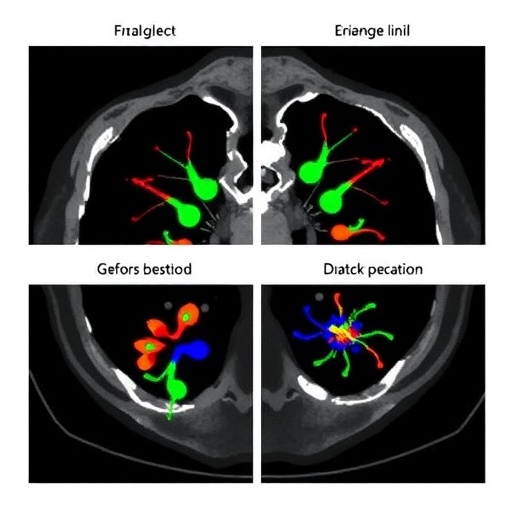Innovations in CRISPR diagnostics have ushered in a new era in disease detection and treatment, allowing for unprecedented sensitivity and multiplexing capabilities that revolutionize healthcare. The latest research conducted by Siddiqui, Welch, and Nguyen opens up intriguing avenues toward enhancing these groundbreaking diagnostic tools through bead-based technologies. Their study delves deep into the mechanics of CRISPR, unveiling methods that would not only amplify its sensitivity but also enable a multipronged approach toward diagnostics, drawing attention from the wider biomedical engineering community and beyond.
At the core of this groundbreaking research lies the CRISPR-Cas9 technology, which has already transformed gene editing across multiple disciplines. This study aims to elevate CRISPR diagnostics—an application of the technology designed to detect specific nucleic acid sequences associated with pathogens. With the current state of diagnostics often constrained by limitations in sensitivity and specificity, Siddiqui and team have proposed bead-based methods to optimize these critical factors. By leveraging beads as carriers for CRISPR components, they envision a more versatile and efficient diagnostic platform.
One of the significant challenges faced in existing CRISPR diagnostic frameworks is the limitation posed by low target concentrations, which may lead to false negatives. The researchers identified that incorporating bead-based approaches could significantly overcome this hurdle. The beads can be engineered to have high affinity for specific target sequences, essentially acting as enhanced lodestones that attract and capture the nucleic acid of interest. This improvement not only increases sensitivity but also promotes consistent and reliable binding, paving the way for more accurate diagnostics.
Multiplexing, the capability to simultaneously detect multiple targets within a single sample, represents another hallmark of modern diagnostics that allows for a broader and richer analysis of pathogens. Traditional methods struggle with this due to complications in signal interference and varying state characteristics of assays. The study illuminates how employing bead-based approaches can facilitate higher multiplexing capabilities. By strategically utilizing multiple beads, each tailored to different targets, the research team demonstrates how to sidestep interference issues, thereby producing clear, separate signals for each target.
Moreover, the bead-based designs can enhance the overall workflow in clinical settings. Traditional reaction formats often involve labor-intensive steps that can lead to human error and variability. However, using beads allows for easier manipulation and a streamlined process where reactions can take place in a single vessel, reducing risks of contamination and enhancing reproducibility. This is particularly crucial in high-throughput settings where scalability and efficiency are paramount.
In addition to augmenting the sensitivity and multiplexing potential, the researchers also discussed the importance of further optimizing the biochemical interactions between the CRISPR components and the beads themselves. Innovations such as custom coatings and various ligand attachments allow for more specialized interactions, ensuring that the right components are active and capable of engaging in the desired reactions. This optimization can extend the shelf-life and functionality of diagnostic kits, making them more viable and user-friendly for clinical applications.
The implications of this research extend well beyond the laboratory. In the realm of public health, enhanced CRISPR diagnostics can provide earlier and more accurate identification of infectious diseases, allowing for prompt and targeted treatments that are crucial during outbreaks. Many pathogens can spread at alarming rates, and having reliable diagnostic tools means interventions can be timely and effectively managed, potentially saving countless lives.
Animal health also stands to benefit significantly from advances in CRISPR diagnostics. Veterinary applications could see improvements in disease management protocols, enabling rapid determination of infectious agents in both domestic and wild animals. Such advancements are crucial in preventing zoonotic diseases that can jump from animals to humans, thereby maintaining a balanced ecosystem and safeguarding global health.
The customization of bead-based assays for patient-specific needs can lead to new paradigm shifts in personalized medicine. With continuous advancements in understanding individual genomic differences, therapies can be tailored to particular genetic profiles. CRISPR diagnostics, enhanced by bead technologies, can help pinpoint the right treatments for patients based on specific genetic makeups, accelerating the approach of individualized therapeutic avenues.
Additionally, the research team touched upon the importance of collaboration in advancing these technologies. Cross-disciplinary partnerships between engineers, biologists, and medical professionals foster innovative solutions that are more impactful. The study emphasizes that collaboration is essential for the successful integration of these advanced diagnostics into everyday healthcare systems. Building a bridge across scientific and industrial sectors will allow for the practical implementation of CRISPR diagnostics that utilize these bead-based enhancements.
This promising approach also addresses the need for cost-effective solutions in diagnostic testing. By simplifying protocols and minimizing resource requirements through bead-based methods, testing could become more accessible and affordable, especially in low-resource settings. The shared goal of democratizing health technology so that everyone, regardless of their economic circumstances, has access to cutting-edge diagnostic tools remains a pivotal driver in the research community.
As the scientific community eagerly anticipates the translation of these research findings into practical applications, the potential to reshape the landscape of diagnostics looks brighter than ever. With ongoing advancements in technology and increased collaborations across fields, the future appears promising for CRISPR diagnostics, with bead-based strategies standing at the forefront.
In closing, Siddiqui and colleagues illuminate a pathway toward the next generation of CRISPR diagnostics that could have lasting impacts on medicine. Through their innovative research on bead-based approaches, they display how scaling the sensitivity, specificity, and multiplexing capabilities of these revolutionary technologies can lead to earlier disease detection, innovative therapies, and improved health outcomes on a global scale. The convergence of science, technology, and practical healthcare solutions carries the promise of a healthier future, all underpinned by the incredible potential of CRISPR diagnostics.
Subject of Research: CRISPR diagnostics and bead-based approaches for increased sensitivity and multiplexing.
Article Title: Bead-based approaches for increased sensitivity and multiplexing of CRISPR diagnostics.
Article References:
Siddiqui, S.M., Welch, N.L., Nguyen, T.G. et al. Bead-based approaches for increased sensitivity and multiplexing of CRISPR diagnostics.
Nat. Biomed. Eng (2025). https://doi.org/10.1038/s41551-025-01498-2
Image Credits: AI Generated
DOI: 10.1038/s41551-025-01498-2
Keywords: CRISPR, diagnostics, bead-based approaches, sensitivity, multiplexing, public health, personalized medicine.
Tags: bead-based sensitivity methodsbiomedical engineering advancementsCRISPR diagnostics innovationsCRISPR-Cas9 technology applicationsenhancing disease detection techniquesgroundbreaking research in gene editingmultiplexing capabilities in healthcareoptimizing diagnostic sensitivity and specificityovercoming low target concentration challengespathogen nucleic acid detectionSiddiqui Welch Nguyen study findingsversatile diagnostic platforms





